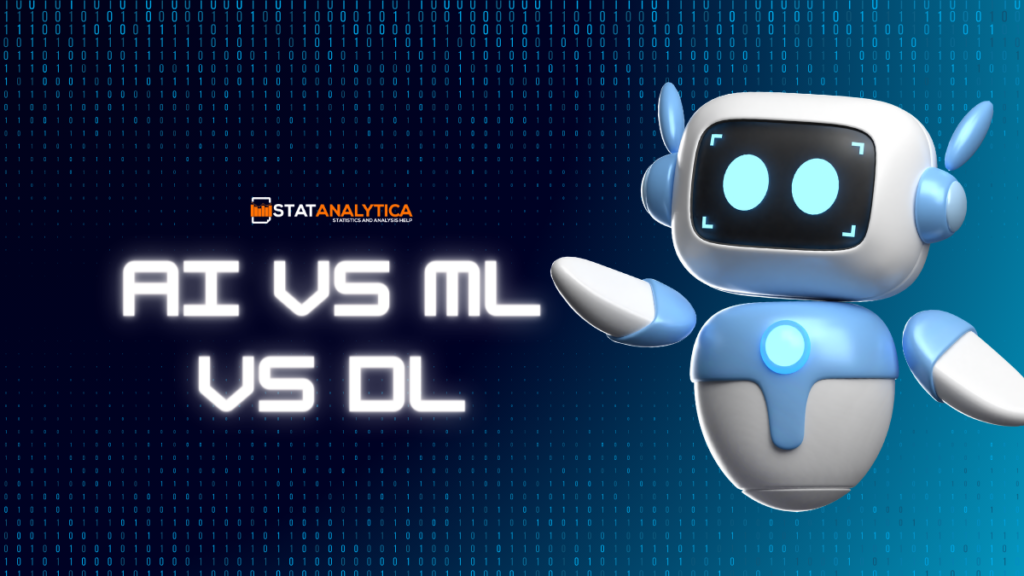In today’s digital age, you often hear terms like Artificial Intelligence (AI), Machine Learning (ML), and Deep Learning (DL) thrown around. But what exactly do these terms mean, and how are they (AI vs ML vs DL) different from each other? Let’s dive in and unravel the mysteries behind these buzzwords.
What Is AL, ML, and DL?
Table of Contents
- Artificial Intelligence (AI) is the cornerstone of computer systems aiming to emulate human intelligence. Dating back to the 1950s, AI has evolved significantly, fostering breakthroughs in natural language processing, computer vision, and robotics.
- Machine Learning (ML), a subset of AI, shows computers how to learn from information without being told exactly what to do. Its algorithms include supervised learning (using labeled data), unsupervised learning (unlabeled data), and reinforcement learning (reward-based decision making). ML powers ubiquitous technologies like recommendation systems and virtual assistants.
- Deep Learning (DL), an advanced form of ML, mimics the brain’s neural networks. With layers of interconnected nodes, DL models autonomously extract features from raw data, enabling tasks like image recognition and natural language processing. From healthcare to finance, DL has reshaped industries, enabling accurate disease diagnosis and fraud detection.
What Is The Difference Between AI and ML and DL?
Now that we’ve covered the basics of AI, ML, and DL, let’s summarize the key differences between them:
- Scope and Approach: AI is the overarching field that encompasses everything related to creating intelligent machines, while ML and DL are specific techniques within AI focused on learning from data.
- Level of Abstraction and Complexity: ML algorithms rely on handcrafted features and explicit programming, while DL models learn feature representations automatically from raw data, making them more complex and powerful.
- Data Requirements and Processing: ML algorithms require labeled or structured data for training, whereas DL models can learn from raw, unstructured data like images, text, or audio.
- Performance and Scalability: DL models tend to outperform traditional ML algorithms on tasks like image and speech recognition but require more computational resources and data to train.
- Examples and Use Cases: AI is applied in many areas, like helping virtual helpers and self-driving cars, as well as in fields like healthcare and finance. ML and DL techniques are employed in specific domains like recommendation systems, computer vision, and natural language processing.
AI vs ML vs DL: Head To Head Comparison
| S. No. | Artificial Intelligence (AI) | Machine Learning (ML) | Deep Learning (DL) |
| 1 | Study/process enabling machines to mimic human behavior through algorithms. | It means that machines learn and get better at tasks by looking at lots of examples and figuring out patterns from them. | Uses Neural Networks to imitate human brain functionality. |
| 2 | Broader family consisting of ML and DL as components. | Subset of AI. | Subset of ML. |
| 3 | Computer algorithm exhibiting intelligence through decision-making. | AI algorithms enable systems to learn from information they receive. | ML algorithm using deep neural networks to analyze data. |
| 4 | Involves complex math and search trees. | Involves math and understanding complex functionalities. | Breaks complex functionalities into lower dimension features. |
| 5 | Aim is to increase chances of success, not just accuracy. | Aim is to increase accuracy, regardless of success ratio. | Attains highest accuracy with large data sets. |
| 6 | Categories: ANI, AGI, ASI. | Categories: Supervised, Unsupervised, Reinforcement Learning. | Network architectures: Unsupervised Pre-trained, CNNs, RNNs, Recursive NNs. |
| 7 | Efficiency relies on ML and DL. | Less efficient for larger data sets. | Powerful for larger data sets. |
| 8 | Examples: Google predictions, ridesharing apps, autopilot. | Examples: Siri, spam filtering. | Examples: Sentiment analysis, image captioning. |
| 9 | Broad field focusing on intelligent machine creation. | Subset focusing on algorithmic learning from data. | Focuses on deep neural networks for automated feature extraction. |
| 10 | Subfields: robotics, NLP, computer vision. | Categorized as supervised, unsupervised, reinforcement learning. | Multi-layered networks for complex data processing. |
Is ML Better Than DL?
Is Machine Learning (ML) better than Deep Learning (DL)? Let’s explore this question through a comparison in points:
Data Complexity
- ML: Works well with structured data and moderate complexity.
- DL: Excels with unstructured data like images, text, and audio, handling high complexity efficiently.
Model Performance
- ML: Provides good performance but may plateau with increased data complexity.
- DL: DL performs exceptionally well, especially with big sets of information, because it can understand complex patterns and details effectively.
Algorithm Complexity
- ML: Utilizes simpler algorithms like decision trees, SVMs, and k-nearest neighbors.
- DL: Employs complex neural network architectures with multiple layers, such as CNNs and RNNs.
Feature Engineering
- ML: Requires manual feature engineering, where experts select and engineer relevant features for model training.
- DL: Automatically learns feature representations from raw data, reducing the need for manual feature engineering.
Computational Resources
- ML: Requires less computational power and resources compared to DL.
- DL: Demands substantial computational resources, including high-performance GPUs or TPUs, for training large neural networks effectively.
Example – Image Classification
- ML: Traditional ML algorithms like SVMs or Random Forests may struggle with complex image datasets due to handcrafted feature limitations.
- DL: DL techniques like Convolutional Neural Networks
(CNNs) excel in image classification tasks, achieving state-of-the-art performance by automatically learning hierarchical features from raw pixel data.
Basically, Machine Learning is good for lots of things, but Deep Learning is even better at handling really complicated data, like pictures, speech, or words. However, which one you pick depends on things like how complicated your data is and how much computer power you have.
Conclusion
In conclusion, Artificial Intelligence, Machine Learning, and Deep Learning are three interconnected concepts that are shaping the future of technology and society. By understanding the differences between them (AI vs ML vs DL), we can better appreciate their capabilities and potential applications.
Whether it’s predicting the weather, diagnosing diseases, or driving autonomous cars, AI, ML, and DL are transforming how we live, work, and interact with the world around us.
So the next time you hear someone talking about AI or ML, you’ll know exactly what they’re referring to – and maybe even impress them with your newfound knowledge!


